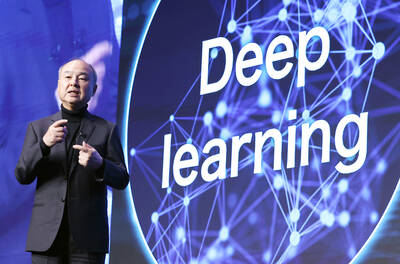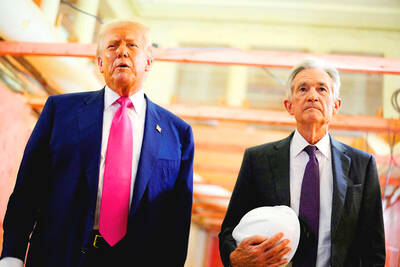Advanced Semiconductor Manufacturing Inc (ASE, 日月光半導體), the world’s top chip packager, yesterday said recovering demand has helped it end two straight quarterly losses. It expected the momentum to gather pace in the current quarter driven mainly by a consumer electronics revival, strengthening the belief that the semiconductor industry is on track for an earlier-than-expected recovery.
ASE swung into net profit of NT$1.67 billion (US$50.88 million), or NT$0.32 a share, in the April-June period on restocking demand, compared with losses of NT$1.57 billion in the first quarter of this year and NT$800 million in the final quarter of last year. A year ago, the company earned NT$2.41 billion.
To cope with improving demand, ASE allocated US$200 million for capital spending this year primarily on advanced technologies, falling in the high end of the range between US$150 million and US$200 million it estimated earlier this year.
“Prices started stabilizing from June because demand is exceeding existing capacities ... We need to build more capacity later this year to meet demand because our utilization is approaching the limit,” chief financial executive Joseph Tung (董宏思) told an investor’s conference.
Prices fell betwenn 3 percent and 5 percent quarter-on-quarter during the April-June period, he said.
This quarter, shipments may grow 15 percent from last quarter, while factory utilization may rise to about 85 percent from 70 percent to 75 percent last quarter, Tung said.
As prices may hold steady this quarter, shipment growth could translate into approximately 15 percent revenue growth for ASE, from NT$20.88 billion in the second quarter.
“The growth is more than our conservative estimate of more than 10 percent increase,” said Randy Abrams, a semiconductor analyst with Credit Suisse.
ASE also beat Abrams’ estimate of NT$0.15 earnings per share.
ASE’s prospects matched the broader view that the semiconductor industry was recovering from the downturn, Abrams said, joining customer Taiwan Semiconductor Manufacturing Co’s (TSMC, 台積電) surprisingly good guidance.
On Thursday, TSMC said it planned to raise capital expenditure by 53 percent to US$2.3 billion for this year and the company’s third-quarter revenue would increase by 20 percent to NT$90 billion from the second quarter.
To meet stronger-than-expected restocking demand, local rival Siliconware Precision Industries Co (SPIL, 矽品精密) is also more willing to spend on new equipment. On Wednesday it said that it may spend more than the NT$4 billion originally budgeted for this year.
This quarter, demand from consumer electronic devices would take over from communication products in leading the recuperation, while computers may show relatively weaker strength, Tung said.
Tung also gave a rough idea about the final quarter, saying it could be a flat period in terms of revenues, compared with the third quarter.
Credit Suisse reiterated its positive view on the stock and retained its rating of Outperform on ASE.

IN THE AIR: While most companies said they were committed to North American operations, some added that production and costs would depend on the outcome of a US trade probe Leading local contract electronics makers Wistron Corp (緯創), Quanta Computer Inc (廣達), Inventec Corp (英業達) and Compal Electronics Inc (仁寶) are to maintain their North American expansion plans, despite Washington’s 20 percent tariff on Taiwanese goods. Wistron said it has long maintained a presence in the US, while distributing production across Taiwan, North America, Southeast Asia and Europe. The company is in talks with customers to align capacity with their site preferences, a company official told the Taipei Times by telephone on Friday. The company is still in talks with clients over who would bear the tariff costs, with the outcome pending further

NEGOTIATIONS: Semiconductors play an outsized role in Taiwan’s industrial and economic development and are a major driver of the Taiwan-US trade imbalance With US President Donald Trump threatening to impose tariffs on semiconductors, Taiwan is expected to face a significant challenge, as information and communications technology (ICT) products account for more than 70 percent of its exports to the US, Chung-Hua Institution for Economic Research (CIER, 中華經濟研究院) president Lien Hsien-ming (連賢明) said on Friday. Compared with other countries, semiconductors play a disproportionately large role in Taiwan’s industrial and economic development, Lien said. As the sixth-largest contributor to the US trade deficit, Taiwan recorded a US$73.9 billion trade surplus with the US last year — up from US$47.8 billion in 2023 — driven by strong

AI: Softbank’s stake increases in Nvidia and TSMC reflect Masayoshi Son’s effort to gain a foothold in key nodes of the AI value chain, from chip design to data infrastructure Softbank Group Corp is building up stakes in Nvidia Corp and Taiwan Semiconductor Manufacturing Co (TSMC, 台積電), the latest reflection of founder Masayoshi Son’s focus on the tools and hardware underpinning artificial intelligence (AI). The Japanese technology investor raised its stake in Nvidia to about US$3 billion by the end of March, up from US$1 billion in the prior quarter, regulatory filings showed. It bought about US$330 million worth of TSMC shares and US$170 million in Oracle Corp, they showed. Softbank’s signature Vision Fund has also monetized almost US$2 billion of public and private assets in the first half of this year,

POWELL SUCCESSOR: US Fed Governor Adriana Kugler’s resignation gives Donald Trump an opening on the board, potentially accelerating his decision on the next chair US President Donald Trump suddenly has a chance to fill an opening at the US Federal Reserve earlier than expected, after Fed Governor Adriana Kugler announced her resignation on Friday. It might also force him to pick the next Fed chair months sooner than he had anticipated. “The ball is now in Trump’s court,” LH Meyer/Monetary Policy Analytics Inc economist Derek Tang said. “Trump is the one who’s been putting pressure on the Fed to do this and that, and Trump says he wants to have his own people on. So now he has the opportunity.” Kugler’s exit unfolds amid unprecedented public pressure